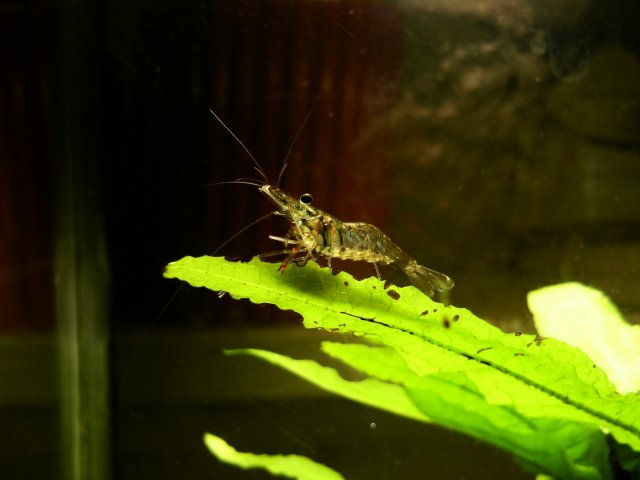Long-armed Shrimp ID - Australian?
- Thread starter bitbot
- Start date
You are using an out of date browser. It may not display this or other websites correctly.
You should upgrade or use an alternative browser.
You should upgrade or use an alternative browser.
Indian Whisker Shrimp
Well, I checked that on Wikipedia and got
"Did you mean: indian whiskey shrine?"
That would make it a Macrobrachium species I think, possibly lamarrei.
It's a juvenile Macro, and a species ID isn't possible, like Cuvier said. I also don't think that it is M. lamarrei (Whisker Shrimp). It does look identical to my young Red Claw shrimp. The scientific species name for Red Claw shrimp is in doubt. It's gone back and forth between M. dayanum, M. assamense and M. assamensis. Personally, I use M. dayanum. Google 'Red Claw shrimp' and you'll find many examples, and of all ages. I would post some of my pictures here, but photobucket is not working right now.
Yes pixl8r, that does look similar.
Anyone have an idea of maximum size, based on the species it might be?
Anyone have an idea of maximum size, based on the species it might be?
Yes pixl8r, that does look similar.
Anyone have an idea of maximum size, based on the species it might be?
I've been breeding Red Claw shrimp for quite some time now. Here's the blurb from one of my old FS threads;
Removed non relevant sales info
Environmental needs
Red Claw shrimp need moderate to medium hard alkaline water. Do not keep in acidic water. Because of their size, two and a half to three inches long (not including their claws), the minimum sized tank is 10 gallons. They do well with water temperatures around 70°F to 80°F. Like all shrimp, they need places to hide when they feel stressed, or when they molt. PVC pipes work great for this purpose. Their tank needs to be filtered. To protect the young, use a sponge filter, or place something over your filter intake. Things that people have used successfully are; sponges, media bags, pantyhose. What ever you use, it is best to boiled it prior to using it in your aquarium. The shrimp are omnivorous and will eat any flake, wafer, or pellet fish food. They also enjoy blanched vegetables and boiled low fat meats such as chicken, salmon or other seafood. Avoid fatty meats, they can quickly foul the water in your tank(s). It is recommended to avoid keeping aggressive fish, such as puffers, cichlids, angles, loaches, etc... with shrimp. Even if the fish are small, they may harass or stress the shrimp to death, or ambush the shrimp after they molt. I don't recommend keeping any species of fish with young infant shrimp at all. The small shrimp most likely will end up as dinner. Like all shrimp, Red Claw shrimp molt. That is, they grow by shedding their carapace, then expand their boddy and harden a new carapace. The new shell is soft, at first, and takes a few hours, or longer, to harden. It is not uncommon for shrimp to loose an appendage, either to a bad molt, or to fighting immediately after molting. Don't worry about lost limbs, shrimp regenerate legs, claws, and antenna. When a crustacean molts, leave the empty shells in the tank for the shrimp to consume. It is a good source of minerals. There may be portions of the carapace that are not eaten. The remnants can sit in the tank without causing any harm.
Social behaviors
As with most Macrobrachium species, Red Claw shrimp have a social hierarchy. One male will grow larger and darker claws than any of his male tank mates. He will tend to be the largest shrimp. In such cases, the large shrimp is referred to as the 'Alpha Male'. The alpha male will create a territory of his own, and keep all other adult male shrimp out of it. However, he will herd female shrimp into his territory and guard them, particularly so when a female is ready to mate. Hence, the alpha male tends to do most, if not all, of the stud work. Unlike dwarf shrimp, this species takes much longer to sexually develop, approximately four months. They also live much longer, to about three years. Feel free to contact me if you have any questions.
Here are a few photos of some of my breeding stock.
Alpha Male

Adult Female

For more pictures feel free to look here,
http://s181.photobucket.com/albums/x130/pixl8r/
Thanks very much pixl8r, that's very helpful. Nice photos too.
It's kind of hard to research when you don't know what you have! - These are my first Macro species and the aquarium shop couldn't tell me, and it's a good one.
Looks like my guys will have to be relocated to another tank fairly soon.
It's kind of hard to research when you don't know what you have! - These are my first Macro species and the aquarium shop couldn't tell me, and it's a good one.
Looks like my guys will have to be relocated to another tank fairly soon.




